In order to acquire and maintain prominent positions on search engine results pages (SERPs), you must remain updated on the ever-changing trends of your audience.
One main strategy that has helped many websites maintain traction in the slippery nature of the SERPs is Establishing Topic Authority.
As we dive deeper into this guide, we’ll explore the concept of keyword and topic clustering, the individual components, and how you can identify them.
Table of Contents
Building topical authority is a more contemporary approach to SEO and content strategy that focuses on establishing expertise, relevance, and credibility within specific topics or subject areas.
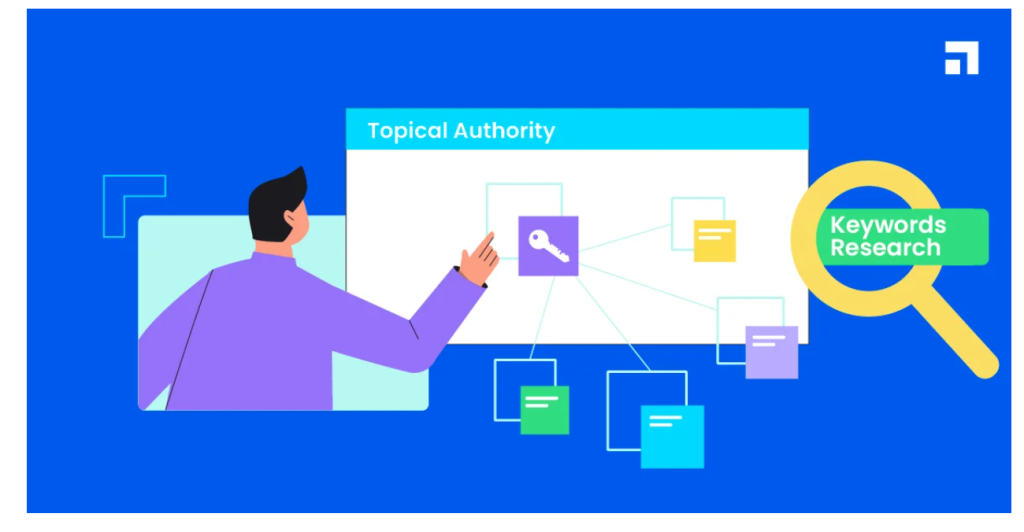
In the earlier days of search engine optimizations, websites focused on stuffing their content with specific keywords, with the primary goal of ranking for specific terms.
It was a numbers game, and those with the most keywords on the target page often emerged victorious in the SERP battle.
Now, as search engines evolved, so did their algorithms.
This transition marked the beginning of a more user-centric SEO approach, where understanding and catering to user intent became critical.
This realization made it important to master topic clusters, a content planning strategy that helps establish authority by exploring your niche in greater depth.
Therefore, keyword and topic clustering is more than just grouping similar terms – it’s about creating a cohesive content strategy that aligns with user intent and search engine algorithms.
Instead of creating isolated pieces of content for each keyword, the idea was to build a network of interlinked content centered around a core topic.
This network, or “cluster,” would consist of a main pillar content piece that provided a comprehensive overview of the core topic, supported by content clusters diving into related subtopics.
The 3 Main Components of a Topic Cluster
Before we dive deeper into keywords and topic clustering, it’s essential to grasp the foundational components that make up a topic cluster.
These 3 components not only streamline your content strategy but also ensure that your content resonates with both search engines and readers.

1. Core Topic (Pillar Content)
The Core Topic, often referred to as the Pillar Content, acts as the central theme around which the entire cluster orbits.
This pillar page is supposed to be comprehensive (targeting 3,000 words or more) and offers a holistic overview of the primary topic.
Therefore, it serves as a foundational stone upon which other related topics rest.
2. Sub-Topics (Cluster Content)
Cluster content, in contrast to the pillar content, takes a magnifying glass to specific subtopics within the core theme.
It’s the exploration of niche areas that provides readers with detailed insights, actionable tips, and focused guidance.
It complements the pillar page by drilling down into the finer details of the subject, with each piece addressing a specific question, concern, or aspect related to the broader topic.
These articles not only enrich the central topic but also create opportunities for valuable internal linking, amplifying the SEO potency of the entire cluster.
3. Internal Links Between Content Cluster and Pillar Page
Internal linking is a critical component of a successful content cluster strategy.
It involves strategically placing links within your content that connect the various pieces of the content cluster to the central pillar page.
These internal links serve several important purposes, such as enhancing the user experience.
From an SEO point, these internal connections distribute “link juice” throughout the cluster, bolstering the ranking potential of each article.
Steps and Strategies to Follow When Keyword and Topic Clustering
These strategies outlined below, when woven together, help implement a solid SEO Content Strategy by pinpointing the right keywords and topics with finesse and flair.
1. Starting with the SEED Phrase/Keyword:
Every successful keyword and topic clustering journey begins with a seed phrase — which is a foundational search query that encapsulates the essence of your Niche/Industry.
Think of it as the starting point from which all other industry keywords branch out.

By building upon this seed, you can craft a robust keyword strategy that resonates with both search engines and readers.
2. Automated Keyword Clustering:
Starting Point: Input your SEED keyword into your favorite SEO Keyword Research tools to get a broad overview of related terms and phrases.
There are numerous tools available that can simplify the process of keyword clustering.
Most of these tools are designed with user-friendliness in mind, and can automatically group keywords based on various criteria, such as search intent or topic relevance.
Recommended Tools: Platforms like SEMRUSH New Keyword Clustering Feature, and Keyword Cupid offer features for automated keyword clustering, streamlining the entire process.

Automated clustering is scalable, making it ideal for handling large keyword datasets.
It also provides quick insights, helping you identify potential topic clusters without manual intervention.
3. Parent Topic Clustering:
From the keyword clusters generated, identify primary or parent topics that can serve as anchors for your topic cluster strategy.
These are broader themes with high search demand.
The obvious benefit of focusing on parent topics is that your content strategy aligns with areas of high interest and search volume.
4. Manual Clustering:
While automated tools provide a great starting point, there’s no replacement for human intuition and understanding.
Manual clustering involves analyzing search results, identifying patterns, and grouping keywords based on themes and user intent.
It’s particularly useful for niche topics or industries with unique jargon or phrases.
Implementation: Dive deeper into each cluster, especially those stemming from your SEED keyword.
Search specific phrases that may appear confusing and analyze SERPs to understand how other websites address the user intent. This gives you an idea of what type of content to create to help the readers.
Then Group the new keywords that share similar content themes or address similar user intents.
Ultimately, this strategy offers a more granular understanding, capturing subtleties that automated tools might overlook.
How to Identify Topic Clusters from Your Keyword Clustering Results
If you’ve been following the guide, I want to believe you now have a refined list of clustered keywords.
Having understood their significance, the next logical step is to translate these insights into actionable plans.
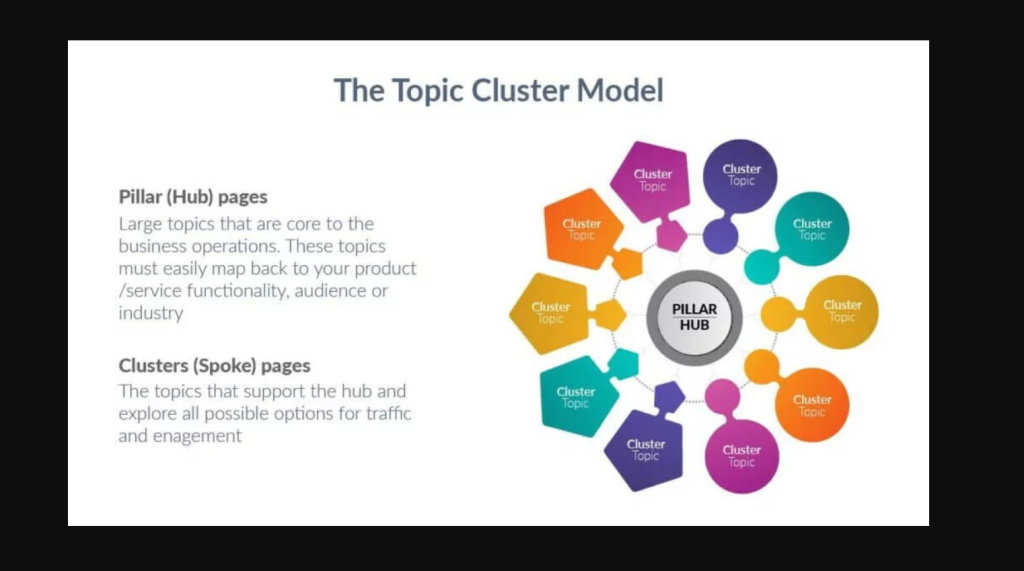
Here’s how you can identify topic clusters from your keyword clustering results and integrate them into your content strategy:
1. Understanding Keyword Clusters as Silos:
Whereas it might be easier to identify topics from SEMRUSH SEO Clustering results, this may not be the case will all other SEO tools.
For instance, keyword clustering tools like Keyword Cupid, often present this data in the form of ‘silos’.
These silos are essentially thematic clusters of search phrases that share a common subject or topic, and also form the basis for developing a comprehensive topic cluster.
Let’s break down this concept:
Website Categories:
Depending on its size, a silo could correspond to a specific content category or section on your website.
For example, if you have a website about fitness, you might have silos for “Cardio Workouts,” “Strength Training,” “Nutrition,” and “Recovery.”
For each category, you should create high-quality, in-depth content that targets the keywords associated with that theme.
However, a successful topic clustering strategy requires the transition of these silos into a more focused topical approach to help create pillar pages and their subsequent content clusters.
2. Transitioning from Silos to a Topical Perspective:
While silos give you a structured view of related keywords, the next step is to think topically.
Instead of seeing them merely as groups of keywords, envision each silo as a comprehensive topic for content creation.
Ask yourself:
- What topical theme does this silo represent?
- What questions are users trying to answer within this theme?
- How can I create content that addresses these questions comprehensively?
Big Silos (Broader Topics):
Big silos can represent primary themes or core categories of your content strategy.
They are bigger topics that can comfortably support the creation of pillar pages.
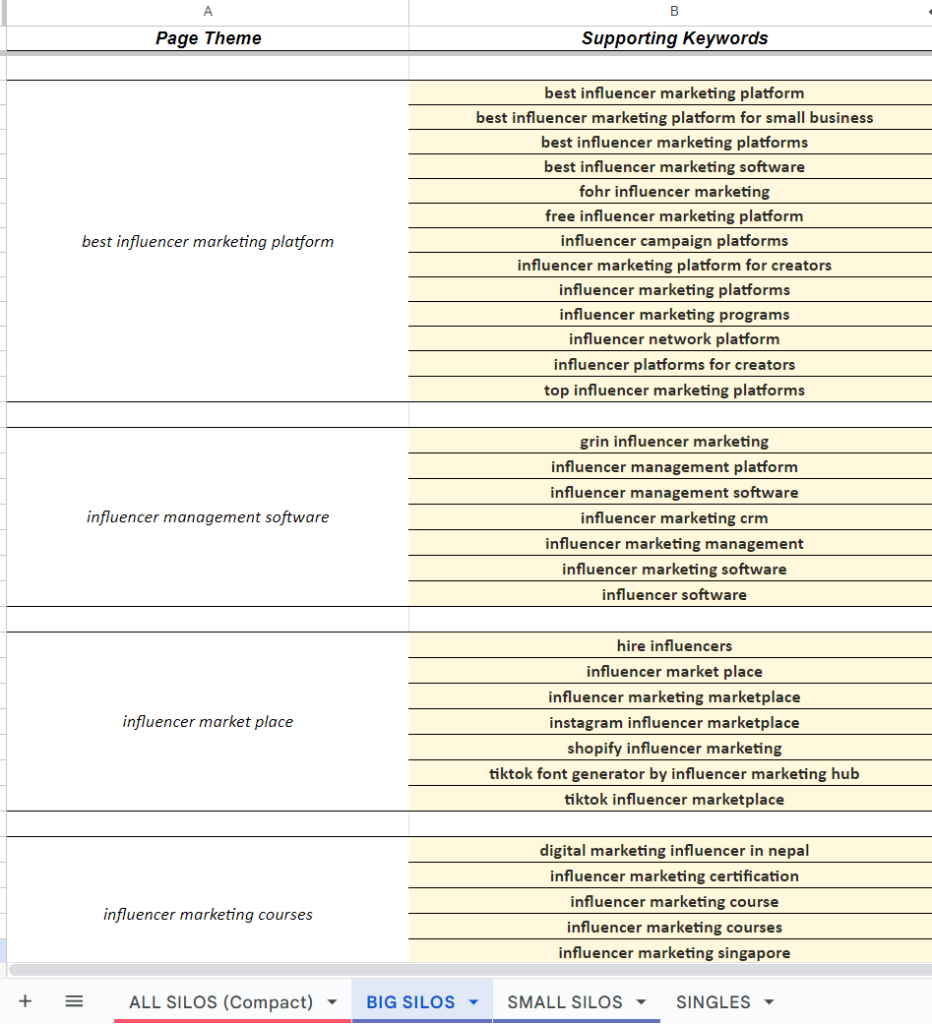
Each of these can become a pillar page that serves as a hub for a broad topic.
Smaller Silos (Narrower Topics):
Smaller silos are more shallow and might encompass only a few related keywords each.
When dealing with smaller silo themes, it’s essential to assess whether they are related ideas that can be grouped into a single, cohesive topic cluster.
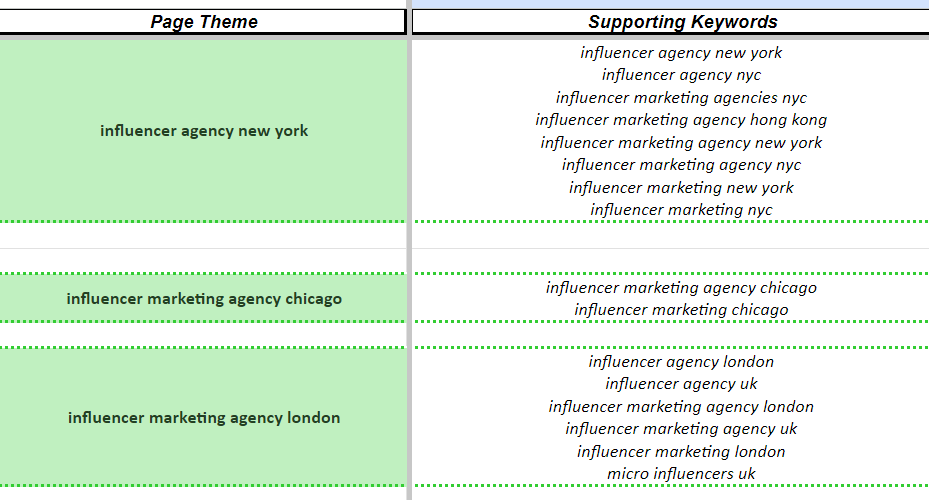
These smaller silos can act as subtopics to allow you to delve into specific aspects of the larger theme.
However, If these smaller silo themes stand on their own as independent clusters, it’s best to treat them individually when creating content.
How They Fit into Topic Clustering:
Pillar Pages: Treat the big silos as a topic cluster, serving as the primary divisions of your content hierarchy.
Therefore, a big silo can become the basis for a pillar page, providing a comprehensive overview of the primary theme.
These pillar pages should be a complete guide that naturally incorporates keywords related to the overarching topic.
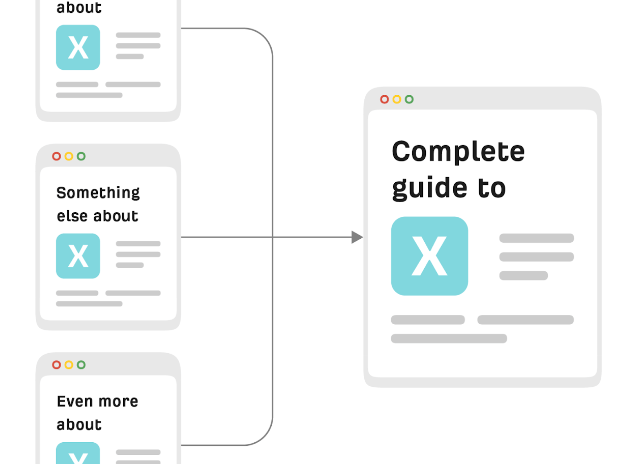
Content Clusters:
Depending on the components of the silo, you can create content clusters by further dividing the topic into smaller, closely related themes or subtopics.
Remember, these pieces of content will act as supporting pages of the pillar page, discussing in detail what you briefly mentioned there.
The advantage of this approach is that it allows you to cover both broad topics comprehensively (via pillar pages) and narrower, more specialized topics within a unified cluster content strategy.
It caters to both users looking for a comprehensive overview and those seeking specific, detailed information within your niche or industry.
3. Leveraging ChatGPT to Help Plan Topic Clusters:
ChatGPT can also help brainstorm content ideas and subtopics for your topic cluster.
By providing the AI with your core topic, it can suggest subtopics and angles to explore within that cluster.
This can diversify your content and provide a more comprehensive coverage of the subject.
Lastly, beyond planning, ChatGPT can offer tips for the actual content creation process of each topic cluster you choose to implement, including the LSI keywords to incorporate.
CONCLUSION
Topic clustering, with its focus on user intent and comprehensive content, represents the future of keyword research.
By transitioning from isolated keyword targeting to a more holistic, topic-centered approach, you can create content that resonates with both search engines and readers.
Whichever strategy you follow when clustering keywords and topics, the goal remains the same: to provide value, establish authority, and build a lasting connection with your audience.



